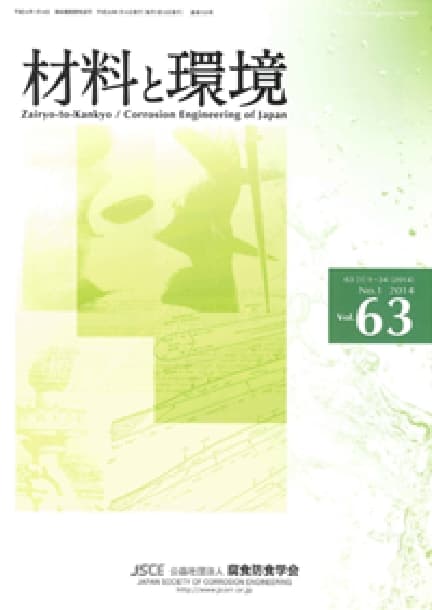- TOP
- Zairyo-to-Kankyo
- Vol. 66 (2017), No. 9
Zairyo-to-Kankyo Vol. 66 (2017), No. 9
Backnumber
-
Vol. 74 (2025)
-
Vol. 73 (2024)
-
Vol. 72 (2023)
-
Vol. 71 (2022)
-
Vol. 70 (2021)
-
Vol. 69 (2020)
-
Vol. 68 (2019)
-
Vol. 67 (2018)
-
Vol. 66 (2017)
-
Vol. 65 (2016)
-
Vol. 64 (2015)
-
Vol. 63 (2014)
-
Vol. 62 (2013)
-
Vol. 61 (2012)
-
Vol. 60 (2011)
-
Vol. 59 (2010)
-
Vol. 58 (2009)
-
Vol. 57 (2008)
-
Vol. 56 (2007)
-
Vol. 55 (2006)
-
Vol. 54 (2005)
-
Vol. 53 (2004)
-
Vol. 52 (2003)
-
Vol. 51 (2002)
-
Vol. 50 (2001)
-
Vol. 49 (2000)
-
Vol. 48 (1999)
-
Vol. 47 (1998)
-
Vol. 46 (1997)
-
Vol. 45 (1996)
-
Vol. 44 (1995)
-
Vol. 43 (1994)
-
Vol. 42 (1993)
-
Vol. 41 (1992)
-
Vol. 40 (1991)
Keyword Ranking
24 Dec. (Last 30 Days)
Zairyo-to-Kankyo Vol. 66 (2017), No. 9
Investigation of Error Reduction Methods for Electrochemical Corrosion Potential Measurement in High Temperature-High Purity Water
Masahiko Tachibana
pp. 289-298
DOI:
10.3323/jcorr.66.289Abstract
The supersensitive measurement method for general electric circuit was applied to the ECP measurement method in high temperature water which simulated BWR temperature condition. Some issues which concerned with the measurement were clarified. Additionally, the countermeasures were divided to reduce measurement errors.
Research of Corrosion Monitoring of Rebar in Concrete with Electrochemical Impedance Spectroscopy
Hiroyuki Tokieda, Tatsuki Okamoto, Yoshinao Hoshi, Isao Shitanda, Masayuki Itagaki
pp. 299-304
DOI:
10.3323/jcorr.66.299Abstract
We developed a probe electrode for impedance measurement to investigate of rebar corrosion in concrete. Impedance measurements of the electrode in an aqueous solution simulating the transition zone of concrete and rebar interface were carried out. The charge transfer resistance Rct obtained from the two point frequency measurement results by the method developed by Haruyama and Tsuru almost agreed with Rct estimated by spectral measurement. It was also confirmed that Rct was drastically decreased by de-passivation following the decrease in pH. Furthermore, impedance measurement of the probe electrode in concrete specimen was carried out.It was confirmed that Rct was small when the depth of setting the probe electrode was shallow. It was concluded that the state of the rebar/concrete interface can be evaluated by Rct of the probe electrode installed in the concrete.
Article Access Ranking
24 Dec. (Last 30 Days)
-
Delayed Fracture Mechanism of 1700 MPa-Class Quenched and Tempered Bolt under Atmospheric Corrosion Environment
Tetsu-to-Hagané Advance Publication
-
Perspectives on the Promising Pathways to Zero Carbon Emissions in the Steel Industry toward 2050
ISIJ International Vol.65(2025), No.2
-
Effect of B on Surface Oxidation Behavior and Phosphatability of Si-Mn-added Cold-Rolled Steel Sheets
ISIJ International Advance Publication
-
Factors Influencing the Bonding Phase Structure of Iron Ore Sinters
ISIJ International Vol.43(2003), No.9
-
Effect of microstructural heterogeneity on fatigue limit of as-quenched low-carbon low-alloy martensitic steel
ISIJ International Advance Publication
-
Prussian blue as a fully reversible hydrogenochromic material for visualizing hydrogen distribution in Fe sheet
ISIJ International Advance Publication
-
From plasticity to fracture in pearlitic microstructures: Atomistic study of cementite thickness and deformation localization
ISIJ International Advance Publication
-
Metallurgical Aspects on Interstitial Free Sheet Steel From Industrial Viewpoints
ISIJ International Vol.34(1994), No.1
-
Abnormal Grain Growth Behavior of Ferrite in Pure Iron with Cold Torsion
Tetsu-to-Hagané Advance Publication
-
Influence of Antimony on the Oxidation Characteristics of 65Mn Steel
ISIJ International Advance Publication
You can use this feature after you logged into the site.
Please click the button below.










